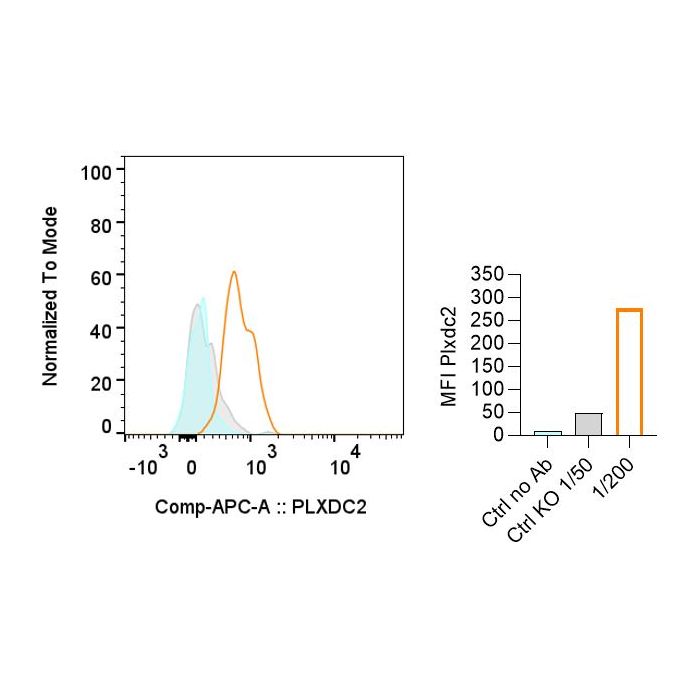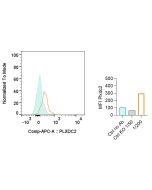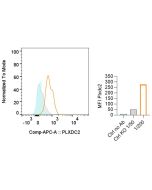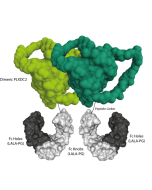Cookie Policy: This site uses cookies to improve your experience. You can find out more about our use of cookies in our Privacy Policy. By continuing to browse this site you agree to our use of cookies.
AdipoGen Life Sciences
anti-PLXDC2 (mouse), mAb (Bonny-1)

Method: 3x10^6 thymocytes from WT or Plxdc2 -/- mice are blocked with FcR Mouse Blocker for 10 min at RT, then stained with anti-PLXDC2, mAb (Bonny-1) in 100µl of FACS buffer (PBS, 2% FCS, P/S, 1mM EDTA) for 20 min at 4°C. The cells are incubated for 15 min at 4°C with a secondary antibody anti-mouse IgG APC diluted at 1/100 in 50µl of FACS buffer. The cells are then stained for surface markers following a standard protocol. Graphs shows DN2 population (CD25+ CD44+) gated from the CD4- CD8- thymocytes. MFI: mean fluorescence intensity. (Picture courtesy of Laurie Bonneaux, Prof. Werner Held Lab, University of Lausanne)
| Product Details | |
|---|---|
| Synonyms | Plexin Domain-containing Protein 2; Tumor Endothelial Marker 7-related Protein |
| Product Type | Monoclonal Antibody |
| Properties | |
| Clone | Bonny-1 |
| Isotype | Mouse IgG2aκ |
| Source/Host | Purified from concentrated hybridoma tissue culture supernatant. |
| Immunogen/Antigen | Recombinant mouse PLXDC2. |
| Application |
Flow Cytometry: (1:200)
|
| Crossreactivity | Mouse |
| Specificity |
Recognizes endogenous mouse PLXDC2. |
| Purity | ≥95% (SDS-PAGE) |
| Purity Detail | Protein G-affinity purified. |
| Concentration | 1mg/ml |
| Formulation | Liquid. In PBS containing 0.02% sodium azide. |
| Isotype Negative Control | |
| Shipping and Handling | |
| Shipping | BLUE ICE |
| Short Term Storage | +4°C |
| Long Term Storage | -20°C |
| Handling Advice |
After opening, prepare aliquots and store at -20°C. Avoid freeze/thaw cycles. |
| Use/Stability | Stable for at least 1 year after receipt when stored at -20°C. |
| Documents | |
| Product Specification Sheet | |
| Datasheet |
 Download PDF Download PDF |
Plexin domain containing 2 (PLXDC2) is a nidogen/plexin homology transmembrane protein encoded by PLXDC2. PLXDC2 is specifically expressed on the surface of macrophages but not neutrophils, T cells or NK cells. PLXDC2 has several functions: i) in the brain, it is involved in the proliferation and differentiation of neural progenitors during the development of the nervous system; ii) in the immune system, PLXDC2 on macrophages binds to secreted PTEN (phosphatase and tensin homolog) to sequentially activate JAK2-STAT1 signaling, reprogram macrophages and drive antitumor immunity. Aberrant expression of PLXDC2 in different cancers has been reported. PLXDC2, together with its homolog PLXDC1, also seems to be the receptor for pigment epithelium-derived factor (PEDF) in endothelial cells.









